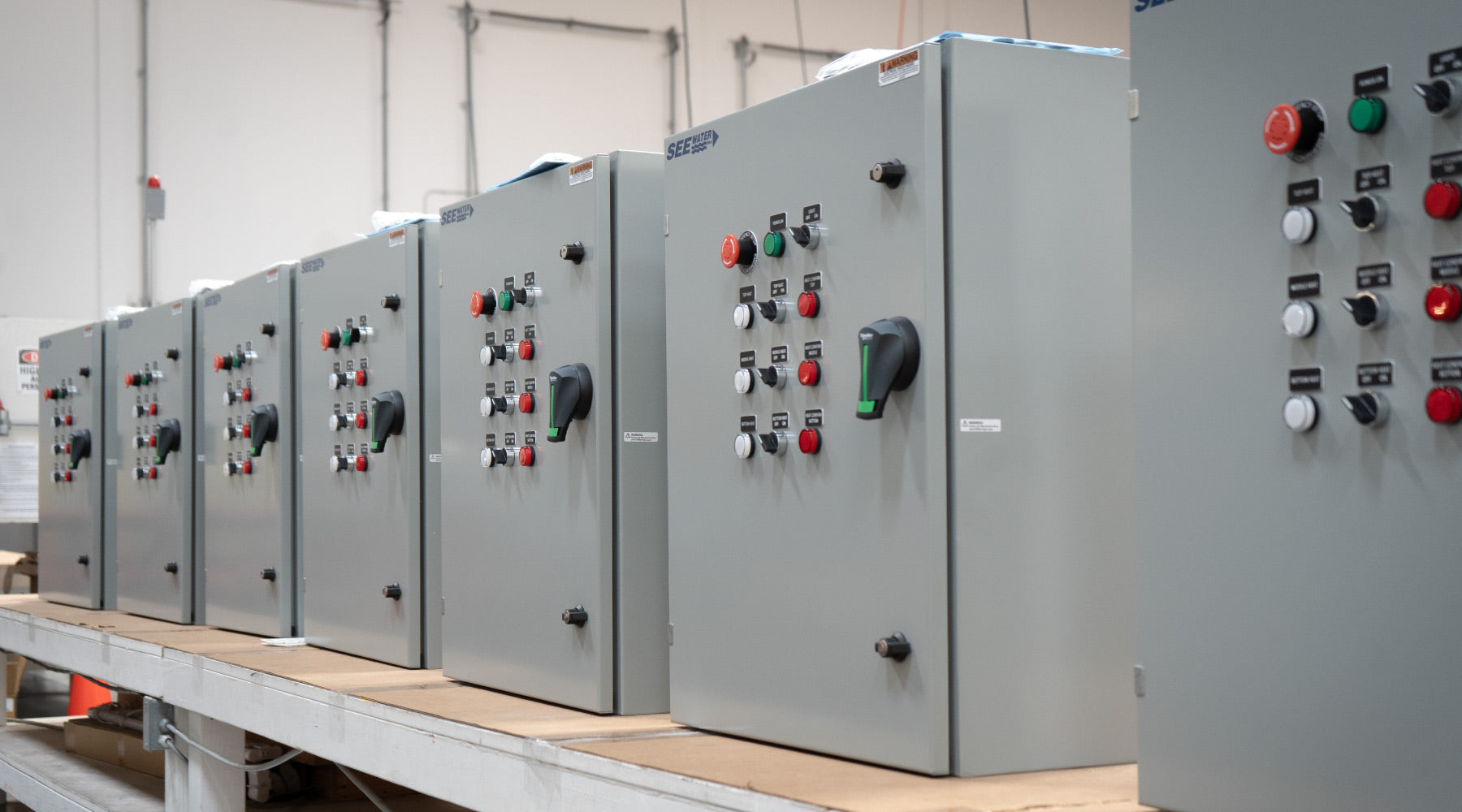By Jesse Goldade
Last updated February 7, 2025
What is a Pump Control Panel?
Pump control panels are vital for ensuring the efficient and reliable operation of water and wastewater systems. These control panels serve as the nerve center for managing the flow of liquids, automating processes, protecting equipment, and monitoring performance. They are used in various industries, from municipal water supply to wastewater treatment and industrial applications. With advanced technologies like automation, remote monitoring, and variable speed control, pump control panels provide enhanced functionality and energy savings.
Key Features of a Pump Control Panel
Pump control panels consist of several core components designed to manage and protect the pump system:
-
Motor Starters and Contractors: Responsible for controlling the pump motor’s power supply, ensuring smooth start/stop operations.
-
Overload Protection: Safeguards the motor by disconnecting power if current levels exceed safe limits.
-
Control Relays and Timers: Manage pump sequencing and timing, crucial in multi-pump systems.
-
Human-Machine Interface (HMI): Provides operators with real-time data and manual control over the pumps.
-
Programmable Logic Controller (PLC): Executes control logic for efficient pump operations, often based on sensor inputs.
-
Variable Frequency Drives (VFDs): Adjust pump motor speed for optimal energy efficiency.
-
Alarm Systems: Alerts operators to operational anomalies, helping prevent damage to the system.
Types of Pump Control Panels
There are several types of pump control panels, each tailored to specific applications:
Simplex Panels
Simplex pump control panels manage a single pump and are suitable for smaller systems. These panels are typically found in residential or light commercial water and wastewater systems.
Duplex Panels
Duplex pump control panel manages two pumps, allowing for redundancy and alternation to balance the wear on both pumps. They are common in larger residential or commercial applications where a backup pump ensures continuous operation.

Triplex and Quad Panels
Triplex (three pumps) and Quad panels (four pumps) are used in high-demand environments like wastewater treatment plants or municipal water systems. They allow the sequencing of multiple pumps based on demand, ensuring efficient handling of fluctuating flow rates.
VFD Panels
Variable Frequency Drive (VFD) panels control the speed of the pumps to optimize energy use. By adjusting motor speed based on real-time demand, these panels can significantly reduce energy consumption, making them ideal for systems where flow rates vary widely.
Soft Starter Panels
Soft starter panels gradually ramp up motor voltage, preventing sudden power surges that can cause wear and tear on pumps. These panels are commonly used in large pump systems to extend motor life and reduce energy costs.
Fire Pump Control Panels
Fire pump control panels are specifically designed to activate fire pumps in emergency situations. They meet strict standards like UL218 and NFPA 20, ensuring that pumps start immediately and operate reliably during critical fire suppression operations.
Benefits of Using a Pump Control Panel
Pump control panels offer a range of benefits that enhance the efficiency, reliability, and safety of water and wastewater systems:
-
Automation: Automatically starts and stops pumps based on data from sensors, reducing the need for manual operation and ensuring consistent system performance.
-
Energy Savings: VFDs and soft starters reduce energy consumption by optimizing pump speed and minimizing power surges during startup.
-
Protection: Built-in overload and dry-run protection safeguard pumps from damage, minimizing repair costs and downtime.
-
Monitoring: Advanced monitoring capabilities allow operators to track system performance and receive alerts for any issues.
-
Redundancy: Duplex, triplex, and quad panels offer backup pumps in case of failure, ensuring uninterrupted operation.
Design Considerations for Pump Control Panels
When designing a pump control panel, several factors must be considered to ensure that the system operates efficiently and safely:
Environmental Conditions
Pump control panels must be designed to withstand the environmental conditions in which they operate, such as extreme temperatures, humidity, and exposure to corrosive chemicals. For example, panels used in wastewater treatment plants require enclosures that protect against moisture and corrosive gases.
System Requirements
It’s essential to choose a control panel that meets the specific needs of the system, including the number of pumps, flow rates, and pressure levels. For larger or more complex systems, multi-pump panels like duplex or triplex panels may be necessary to handle the demand.
Compliance with Standards
Control panels must comply with industry standards to ensure safety and reliability. Choosing a manufacturer certified as a UL508A Panel Shop ensures the panel adheres to standards for industrial control panels. For specialized applications, certifications like UL698 (hazardous locations) or UL218 (fire pump control panels) are critical.
Ease of Use
User-friendly designs with clear labels, indicators, and labeled wires make pump control panels easier to operate and maintain. Accessibility for maintenance personnel is essential, as it reduces the risk of errors and facilitates quicker troubleshooting.
Space and Layout
Proper layout is essential to ensure that components inside the panel are easy to access for maintenance. Sufficient space should be allotted to avoid overcrowding, which can lead to overheating and complicated troubleshooting.
The Future of Pump Control Panels
As technology continues to evolve, the future of pump control panels is marked by increasing automation, connectivity, and energy efficiency. Some emerging trends include:
IoT Integration
With the Industrial Internet of Things (IIoT), pump control panels are becoming more connected, enabling remote monitoring, diagnostics, and control via cloud-based platforms. This allows for real-time data access and predictive maintenance.
Energy Efficiency
As energy costs rise and environmental regulations become stricter, energy efficiency is a top priority. Future control panels will incorporate more advanced VFDs, smart algorithms, and energy-monitoring tools to optimize energy use.
Advanced Monitoring and Analytics
As control panels become more intelligent, they will provide operators with deeper insights into system performance. Advanced data analytics can be used to optimize pump operations, predict potential failures, and reduce downtime.
User-Friendly Interfaces
New control panels are being designed with intuitive touchscreen interfaces, providing operators with real-time data, simplified controls, and visualizations of system performance. Pacific 2.0, for example, is a next-generation control panel interface focusing on usability and integration with smart technologies.
Conclusion
Pump control panels play a pivotal role in water and wastewater management systems. From automating operations to providing redundancy, monitoring, and protection, these panels ensure that systems run efficiently and safely. When designing or selecting a pump control panel, factors like environmental conditions, system requirements, and compliance with standards such as UL508A must be considered. As technology advances, the integration of IoT, energy efficiency improvements, and more user-friendly interfaces promise to enhance the functionality and efficiency of pump control systems further.
For complex systems or specialized applications, partnering with a certified UL508A Panel Shop is essential to ensure compliance and long-term reliability. The future of pump control panels is geared towards increased connectivity, advanced monitoring, and energy-saving solutions, making them indispensable in the evolving landscape of water and wastewater management.
References
- Pumps and Systems Magazine, accessed August 16, 2024
- "Pumping Stations in Wastewater Collection Systems," Water Environment Federation, accessed August 16, 2024
- "Wastewater Pumping Systems," American Water Works Association (AWWA), accessed August 16, 2024
- "Submersible Sewage Pumping Systems Handbook", Submersible Wastewater Pump Association (SWPA), Fourth Edition
Featured image courtesy of See Water, Inc.





Share:
Using IIoT in the Pump Industry
What is Quality Control?